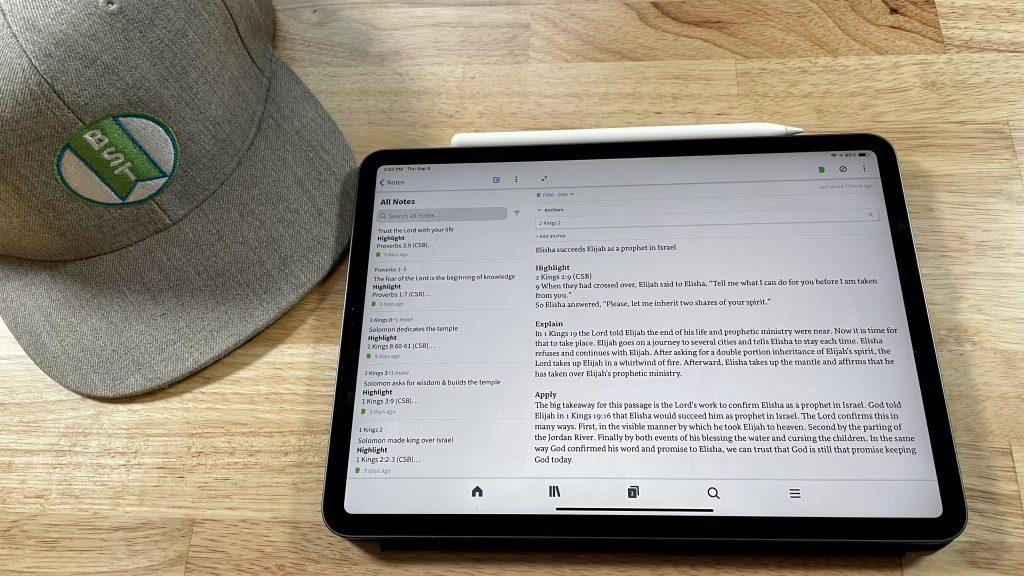What do you do when someone approaches you wanting to study the Bible? They know nothing and don’t know where to start. How would you approach the situation? Do you hand them a book of daily devotions like Our Daily Bread or John Piper’s Taste and See? How about handing them a study Bible and sending them on their way? Or do you tell them to talk to your pastor?
All of these proposed solutions are lackluster. There is a fundamental problem with all of them: they leave the person dependent on someone else, unequipped to study the Bible for themselves. Each solution prepackages an understanding or teaching based on the Bible; but, they do not sustain the new disciple for long. If we use the popular fishing parable, this is like handing someone a fish & only feeding them for a day.
The better solution is to teach this young disciple how to fish so he can feast for a lifetime. In terms of Bible study, this happens when you give someone an easy, yet repeatable, method for studying God’s Word. You enable them to dig into the Scriptures for themselves without unnecessarily being dependent on someone else’s teachings.
This is why I was so excited when my friend Alex Rodriguez, from the Men’s Muster, told me about the book Seven Arrows by Matt Rogers & Donny Mathis. This book provides an answer to the above dilemma by giving Christians a method of Bible study that is simple and effective. These men understand that the biggest determining factor in spiritual growth is consistent Bible reading; so, they want to make sure Christians have a path forward.
Stop asking 'How did my pastor do that?' Seven Arrows equips you to answer that question! Share on XWhat I want to do in this Bible study tip is introduce you to the Seven Arrows method of Bible study & briefly describe each step in the process. So, let’s dive in!
The Seven Arrows Method
The Seven Arrows method is the brainchild of Matt Rogers. After planting a church in Greenville, South Carolina, he began meeting regularly with a young man in his congregation. This young man was full of questions about God’s Word, but he didn’t know where to start studying. He embodied our scenario from the introduction. Sure, he read his Bible & asked questions, but he didn’t have a plan for study or growth. This ultimately led to confusion & doubt.
In response, Matt came up with a plan to help this young man study God’s Word. He knew he couldn’t hand him a stack of theology books, nor did he want to give him a set of rules. So, he began doodling on a napkin the steps & questions he used when studying a passage, using arrows to indicate meaning.
What emerged from Matt’s few moments of doodling was the Seven Arrows method of Bible study: a series of seven questions we can use to understand & apply any passage. As we answer these questions the meaning of the text becomes clear, and we also walk away with real application for ourselves & others.
Seven Arrows is a series of seven questions you can use to understand & apply any passage in the Bible Share on XBelow we’ll briefly look at each arrow and how it’s used in our Bible study.
Using Seven Arrows in Bible Study
Arrow 1

The first arrow is circular & wraps around itself to make a dot. Our goal here is to figure out what the passage says. Before we can do anything else with the text, we need to answer this question.
Too often, we rush our Bible reading. That’s not good. Instead, we need to slow our reading pace to see what’s in the text. When we take our time, it’s easier to make observations of the text. As we do, figuring out the main point becomes easier. Look at it this way, if all we ever do is look at a forest as that, we lose its beauty & every forest looks the same. Yet, when we stop to look at the individual trees & plants, the forest comes alive & we see its uniqueness. The same holds true in Bible study.
Can you summarize the main point of your passage in a sentence or two? Don’t move to the next arrow until you can.
Arrow 2

Next is a backward pointing arrow. This arrow asks, “What did this passage mean to the original audience?” We must remember that each book of the Bible was written to a specific group of people who lived long ago. We do ourselves a disservice if we fail to understand what a book or passage meant to its original readers.
At this step we’re starting to use the Bible study library we have at our disposal. Start with the Bible’s cross-references & read related verses. From there, we can venture out to other tools such as: maps, Bible dictionaries, study Bible notes, and commentaries. It’s hard to figure out what a passage meant to its original audience without context, and these tools help provide that context. Yet, we shouldn’t become so obsessed with these tools that we spend more time with them than our Bible. Remember, the Bible alone is God’s Word and our tools are only supplemental.
Once we understand how the original recipients would have understood the text, we’re equipped and ready to move on to the next arrow.
Arrow 3
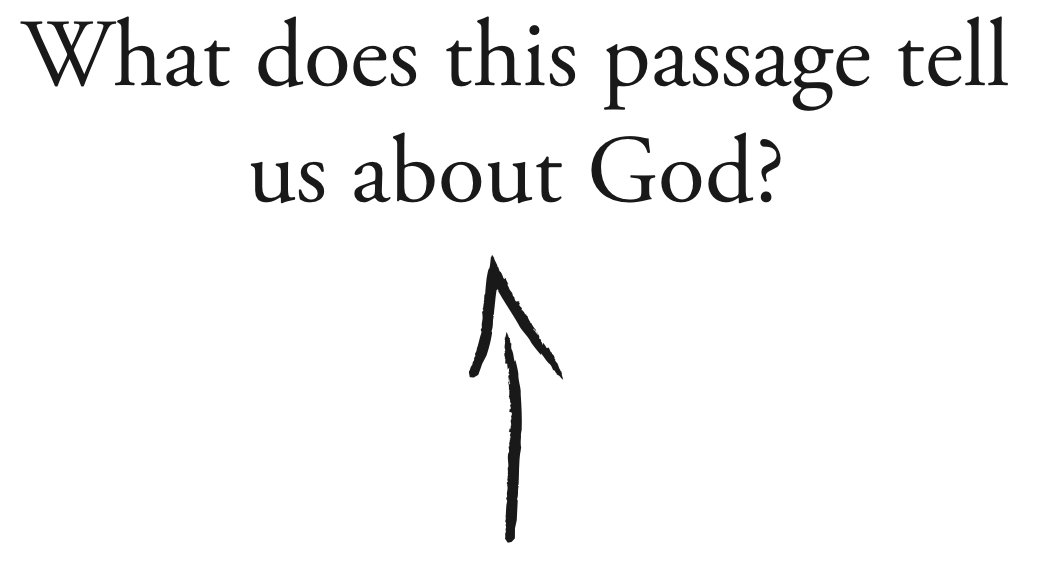
What does this passage say about God? This third question is symbolized by an arrow pointing up. Like the great urban theologian Timothy Brindle says, “Y’all should be mindful of this devout thesis: all of the Bible is about Jesus!” Thus, we would be remiss to not look for God in the middle of each & every passage we read. What do we learn about God in what we’re reading?
Without this arrow’s emphasis many people go wrong in their Bible study. First and foremost, the Bible is God’s Word about himself. It is only about us in so much as it relates to him. That means we need to look for what a text tells us about God.
In this step we must look for words that describe God & mark them in our Bible. How does the passage point to Christ, either forward or back? What does it show us about God’s person and character? How does the passage help us worship God better?
The more we know and understand about God, the better we can answer questions about ourselves and how the Bible relates to us. But, without this step, we’re missing the mark of Bible study.
We'll never interpret the Bible rightly if we don't keep God at the center. Share on XArrow 4

Fourth, we have an arrow pointing down. This arrow poses the question, “What does this passage tell us about man?” Just like every passage tells us about God, it also teaches us something about humanity. In this question we grapple with questions like the sinful condition of man and the life of those redeemed by Christ Jesus.
With a proper view of God we avoid the misstep of making the Bible and its interpretation all about us. Yet, we are God’s image bearers, and we must view man in the Bible in light of this truth. Therefore, when we look at passages like the Old Testament we should see our depravity & constant need for a redeemer and savior. Whereas, in many of the New Testament epistles, we find encouragement for how man ought to live as God’s new creation.
The narrative of the man’s Fall & redemption is key to the Bible, and we should look for it on every page.
Arrow 5
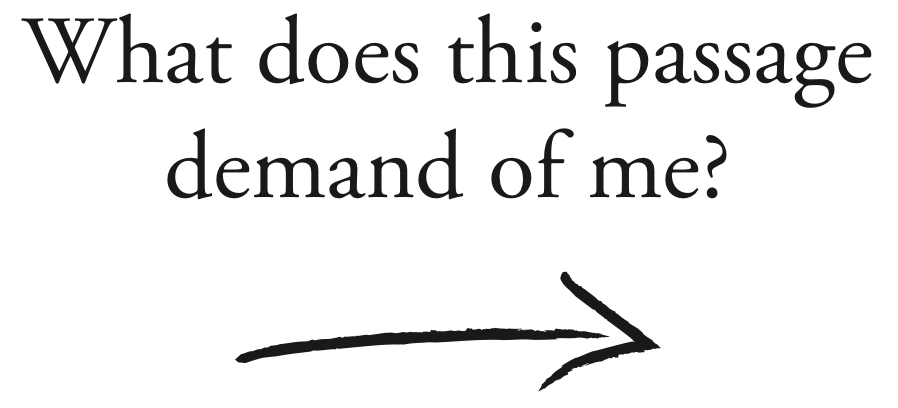
With academics out of the way, now we can jump to everyone’s favorite part of Bible study: application! Arrow 5 points forward and asks the question, “What does this passage demand of me?”
This is a more meaningful question than asking what does the passage mean to you. Every passage requires some kind of response from us, and it is our job to figure out what it is. It’s not about “What does this passage mean to me?” but “What is God telling me to do?”
To find our application, we begin by taking everything we’ve learned in the first 4 arrows. If we know the main point, how the original audience understood it, and how it points to God & man, we should be able to see the application. Any given passage wants us to: 1) know something, 2) be something, or 3) do something. So, start simply. Is it obvious in the text? If not, think bigger & how the passage fits in with the overall narrative of the Bible. Use the arrows to your advantage.
Whatever the application, we must make sure we’re living it out. Don’t just read it, believe & live it!
Whatever the Bible application, we must make sure we’re living it out. Don’t just read the Bible, believe & live it! Share on XArrow 6
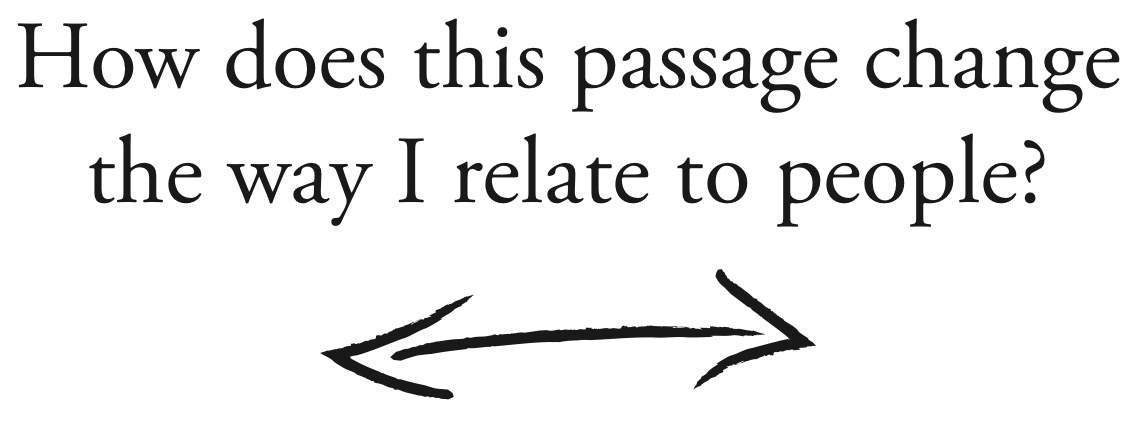
While most people stop at applying the text to themselves, arrow 6 forces us to find corporate application. With an arrow pointing forward & back, we must look at how the Bible not only relates to us as individuals, but also to our neighbor. We do not live the Christian life in isolation from one another, and there are so many “one another” passages in the Bible, so we must ask the question, “How does this passage change the way I relate to people?”
Again, we use the same steps from arrow 5 and look for corporate application. Turn the application from “I” to “We.” Here we apply it to our family, our church, and to the world as our mission field. When we read the Bible in this way, it expands our thinking beyond self.
We’re not alone in this world or in the Church, so our Bible reading should reflect that.
Arrow 7
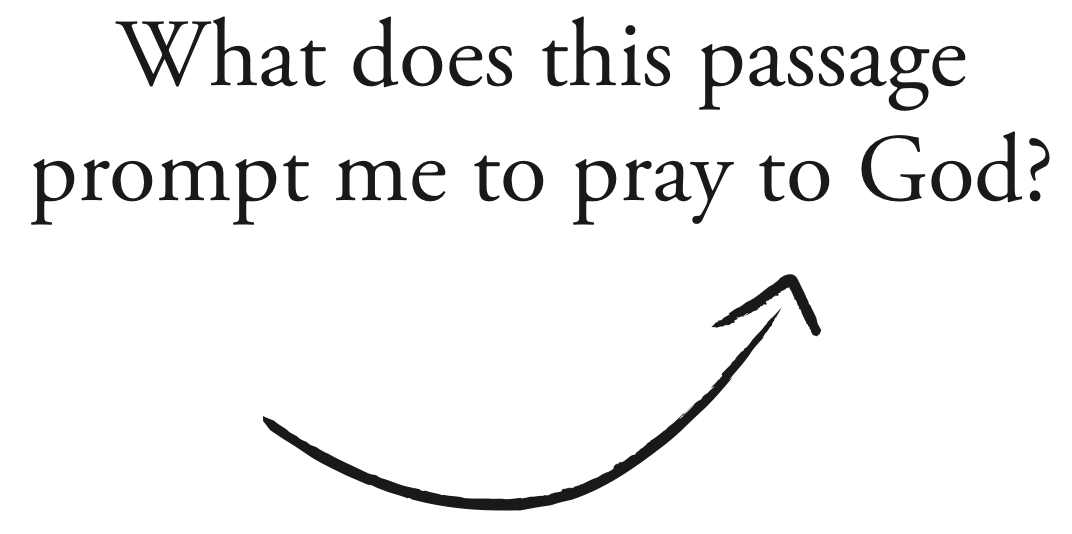
Finally, arrow 7 encourages us to end with prayer, represented by a curved arrow pointing forward. Given everything we unearthed in our studies using arrows 1-6, we should now be able to ask the question, “What does this passage prompt me to pray?” Every page of Scripture should encourage and strengthen our prayer life; and, as such, should direct our prayers to God.
Conclusion
This has only been a very brief look at the Seven Arrows Bible study method. I highly encourage picking up the book in paperback or digital format so you can read the full details of how each arrow works to unpack the truth of Scripture. With Seven Arrows you’ll have a full quiver to approach any passage of the Bible confidently.
With Seven Arrows, no longer will you ask, “How did my pastor do that?” You’ll have everything you need to study the Bible the same way he does.
My challenge to you this week is to use the Seven Arrows method in your time of study this week. Give it a try!
Finally, visit SevenArrowsBible.com & download a copy of the bookmark to keep in your Bible to remind you of the steps.
Weekly Study Prompts
This week, meditate and journal on the following passages:
- Monday – 2 Samuel 1; 2:1-7
- Tuesday – 2 Samuel 3:1; 5; Psalm 23
- Wednesday – 2 Samuel 6-7
- Thursday – Psalm 18; 2 Samuel 9
- Friday – 2 Samuel 11-12
- Memory Verses: Psalms 23:1-3; 51:10-13
Free Bible Study eBook
Enter your name & email below to get a free copy of our "Bible Study Blitz" ebook that will give you 5 tips to enhance your Bible study.





